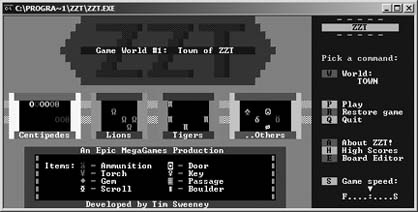Design Games with ZZT
Use a retro game to quickly and easily make new retro games.
What do the names “Tim Sweeney” and "Epic Megagames” mean to you? For most people reading this book, they probably conjure up images of Unreal Tournament.
Not so for me.
When I hear those names, I instantly flash back to 1993. It’s seventh grade, and I’m making my own video games using ZZT. Sweeney’s creation, the very first game released under the Epic Megagames name, was an unassuming piece of software from the outside. You could play a top-down action/ adventure/puzzle game that used ASCII text for all of its graphics. Register the program by sending Tim a few bucks, and he’d send you a disk with three more adventures.
But underneath that façade, Sweeney’s game had a feature that made ZZT much more than a simple adventure game. Instead of pressing P at the title screen (shown in Figure 8-1) to play the game, you could press E and make your own game using the simple and fun (if not always intuitive) game design tool.

Figure 8-1. The title screen of ZZT
Immediately, ZZT fans were making and sharing their own games, and the popularity of the software grew and grew even as Epic had completely moved on to bigger and better games. Intrepid hackers started devising their own tools that pushed the boundaries of the ZZT design tool, making it do things it was never intended to. Soon, Sweeney’s own games looked ...
Get Retro Gaming Hacks now with the O’Reilly learning platform.
O’Reilly members experience books, live events, courses curated by job role, and more from O’Reilly and nearly 200 top publishers.

